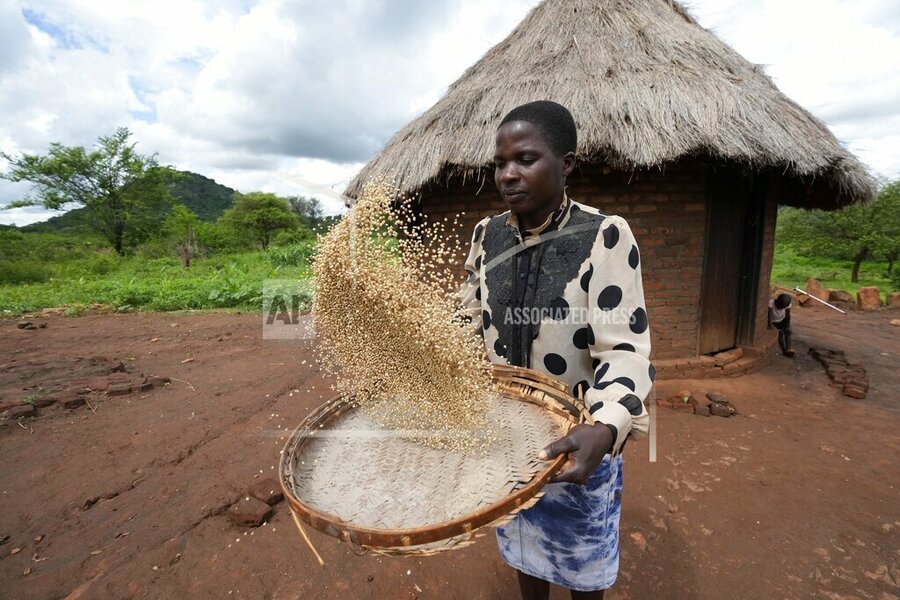Ancient millets offer new hope for crop sustainability, says UN
Loading...
| Rushinga, Zimbabwe
While others in her Zimbabwean village agonize over a maize crop seemingly headed for failure, Jestina Nyamukunguvengu picks up a hoe and slices through the soil of her fields that are lush green with a pearl millet crop in the African country’s arid Rushinga district.
“These crops don’t get affected by drought, they are quick to flower, and that’s the only way we can beat the drought,” she said, smiling broadly. Millets, including sorghum, now take up over two hectares of her land – a patch where maize was once the crop of choice.
Farmers like Ms. Nyamukunguvengu in the developing world are on the front lines of a project proposed by India that has led the U.N.’s Food and Agricultural Organization to christen 2023 as “The Year of Millets,” an effort to revive a hardy and healthy crop that has been cultivated for millennia – but was largely elbowed aside by European colonists who favored corn, wheat, and other grains.
The designation is timely. Last year, drought swept across much of eastern Africa; war between Russia and Ukraine upended supplies and raised the prices of foodstuffs and fertilizer from Europe’s breadbasket; worries surged about the environmental fallout of cross-globe shipments of farm products; many chefs and consumers are looking to diversify diets at a time of excessively standardized fare.
All that has given a new impetus to locally grown and alternative grains and other staples like millet.
Millets come in multiple varieties, such as finger millet, fonio, sorghum, and teff, used in the spongy injera bread familiar to fans of Ethiopian cuisine. Proponents tout millets for their healthiness – they can be rich in proteins, potassium, and vitamin B – and most varieties are gluten-free. And they’re versatile: useful in everything from bread, cereal, and couscous to pudding and even beer.
Over centuries, millets have been cultivated around the world – in places like Japan, Europe, the Americas, and Australia – but their epicenters have traditionally been India, China, and sub-Saharan Africa, said Fen Beed, team leader at FAO for rural and urban crop and mechanization systems.
Many countries realized they “should go back and look at what’s indigenous to their agricultural heritage and what could be revisited as a potential substitute for what would otherwise be imported – which is at risk when we had the likes of pandemic, or when we have the likes of conflict,” said Mr. Beed.
Millets are more tolerant of poor soils, drought, and harsh growing conditions, and can easily adapt to different environments without high levels of fertilizer and pesticide. They don’t need nearly as much water as other grains, making them ideal for places like Africa’s arid Sahel region, and their deep roots of varieties like fonio can help mitigate desertification. This process transforms fertile soil into the desert, often because of drought or deforestation.
“Fonio is nicknamed the Lazy Farmers crop. That’s how easy it is to grow,” says Pierre Thiam, executive chef and co-founder of New York-based fine-casual food chain Teranga, which features West African cuisine. “When the first rain comes, the farmers only have to go out and just like throw the seeds of fonio. ... They barely till the soil.”
“And it’s a fast growing crop, too: It can mature in two months,” he said, acknowledging it’s not all easy: “Processing fonio is very difficult. You have to remove the skin before it becomes edible.”
Millets account for less than 3% of the global grain trade, according to FAO. But cultivation is growing in some arid zones. In the Rushinga district, land under millets almost tripled over the past decade. The U.N.’s World Food Program deployed dozens of threshing machines and gave seed packs and training to 63,000 small-scale farmers in drought-prone areas in the previous season.
Low rainfall and high temperatures in recent years in part due to climate change, coupled with poor soils, have doused interest in water-guzzling maize.
“You’ll find the ones who grew maize are the ones who are seeking food assistance, those who have grown sorghum or pearl millet are still eating their small grains,” said Melody Tsoriyo, the district’s agronomist, alluding to small grains like millets, whose seeds can be as fine as sand. “We anticipate that in five years to come, small grains will overtake maize.”
Government teams in Zimbabwe have fanned out to remote rural regions, inspecting crops and providing expert assistance such as through WhatsApp groups to spread technical knowledge to farmers.
WFP spokesman Tatenda Macheka said millets “are helping us reduce food insecurity” in Zimbabwe, where about a quarter of people in the country of 15 million – long a breadbasket of southern Africa – are now food insecure, meaning that they’re not sure where their next meal will come from.
In urban areas of Zimbabwe and well beyond, restaurants and hotels are riding the newfound impression that a millet meal offers a tinge of class, and have made it pricier fare on their menus.
Mr. Thiam, the U.S.-based chef, recalled eating fonio as a kid in Senegal’s southern Casamance region but fretted that it wasn’t often available in his hometown – the capital – let alone New York. He admitted once “naively” having dreams of making what’s known in rural Senegal as “the grain of royalty” – served to honor visiting guests – into a “world class crop.”
He’s pared back those ambitions a bit but still sees a future for the small grains.
“It’s really amazing that you can have a grain like this that’s been ignored for so long,” Mr. Thiam said in an interview from his home in El Cerrito, California, where he moved to be close to his wife and her family. “It’s about time that we integrate it into our diet.”
This story was reported by The Associated Press. Jamey Keaten reported from Geneva. Haven Daley in El Cerrito, California, contributed to this report.







